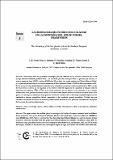Por favor, use este identificador para citar o enlazar a este item:
http://hdl.handle.net/10261/35139COMPARTIR / EXPORTAR:
 SHARE
BASE SHARE
BASE
|
|
| Visualizar otros formatos: MARC | Dublin Core | RDF | ORE | MODS | METS | DIDL | DATACITE | |

| Título: | La cronología del último ciclo glaciar en las montañas del sur de Europa. Una revisión |
Otros títulos: | The chronology of the last glacial cycle in the Southern European mountains. A review | Autor: | García-Ruiz, José María CSIC ORCID ; Moreno Caballud, Ana CSIC ORCID ; González-Sampériz, Penélope CSIC ORCID ; Valero-Garcés, Blas L. CSIC ORCID ; Martí Bono, Carlos Enrique CSIC | Palabras clave: | Glacial chronology Last Glacial Maximum Radiocarbon OSL Cosmogenics Mediterranean mountains Cronología glaciar Último Máximo Global Radiocarbono Cosmogénicos Montañas mediterráneas |
Fecha de publicación: | 2010 | Editor: | Sociedad Española de Geomorfología Asociación Española para el Estudio del Cuaternario |
Citación: | Revista Cuaternario y Geomorfología 24(1-2): 35-46 (2010) | Resumen: | [EN]: This paper reviews the available glacial chronology in the Southern European mountains based on different
dating procedures. The results distinguish between glaciers that reach their maximum extent ca. 50,000 or
even 80,000 years B.P., that is, much earlier than the global Last Glacial Maximum, and (ii) glaciers whose
maximum advance coincides with the global Last Glacial Maximum (20,000 – 18,000 cal. years BP). In
the former ones glaciolacustrine and morainic deposits were dated using radiocarbon, OSL and U-Th series
techniques, whereas in the second ones cosmogenic exposure ages of surfaces and boulders were obtained. The authors conclude that an early maximum advance of the Southern European glaciers would be possible
taking into account their high sensitivity to climate changes during the last glacial cycle. Nevertheless, the
differences between the glaciers located in the Southern European mountains can not be only explained by
the geographic location (latitude, exposure) and the changes in the General Atmospheric Circulation.
Errors in the dating procedures or in the selection of the sampling points have to be evaluated as
responsible for the remarkable differences between Mediterranean mountains. [ES] Este trabajo revisa las principales cronologías glaciares obtenidas en los macizos montañosos del sur de Europa mediante diferentes procedimientos. Los resultados permiten distinguir entre (i) glaciares que alcanzan su máxima extensión hacia 50,000 o incluso 80,000 años BP, es decir, con mucha antelación al Último Máximo Global, y (ii) glaciares que coinciden en su máximo avance con el Último Máximo Global (20,000-18,000 años calendario BP). En los primeros se han datado depósitos glaciolacustres y depósitos morrénicos mediante radiocarbono, OSL y series de Uranio-Torio, mientras en los segundos se ha datado la edad de exposición de superficies y bloques mediante elementos cosmogénicos (10Be y 36Cl). Los autores concluyen que un máximo muy anticipado en las montañas mediterráneas sería posible teniendo en cuenta su alta sensibilidad frente a cambios climáticos durante el último ciclo glaciar. Sin embargo, las diferencias entre glaciares situados en montañas del sur de Europa no pueden explicarse sólo atendiendo a factores geográficos (latitud, exposición) o de circulación general atmosférica. También hay que considerar los posibles errores en los distintos procedimientos de datación o las peculiares características de algunos de los puntos de muestreo seleccionados. |
Descripción: | 132 páginas, 2 figuras. | Versión del editor: | http://tierra.rediris.es/CuaternarioyGeomorfologia/vol2010-1.htm | URI: | http://hdl.handle.net/10261/35139 | ISSN: | 0214-1744 |
| Aparece en las colecciones: | (IPE) Artículos |
Ficheros en este ítem:
| Fichero | Descripción | Tamaño | Formato | |
|---|---|---|---|---|
| Cuater%2024(1-2)_(02)Garcia-Ruiz.pdf | 290,9 kB | Adobe PDF |  Visualizar/Abrir |
CORE Recommender
Page view(s)
972
checked on 18-abr-2024
Download(s)
470
checked on 18-abr-2024
Google ScholarTM
Check
NOTA: Los ítems de Digital.CSIC están protegidos por copyright, con todos los derechos reservados, a menos que se indique lo contrario.
